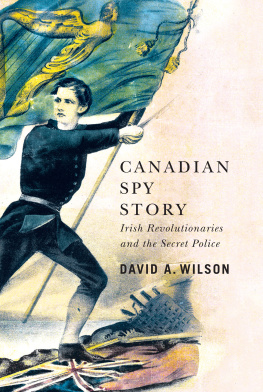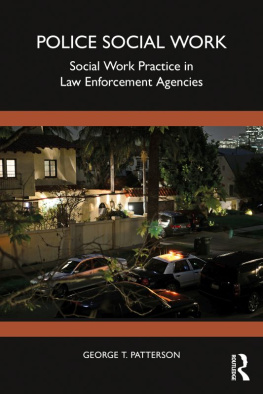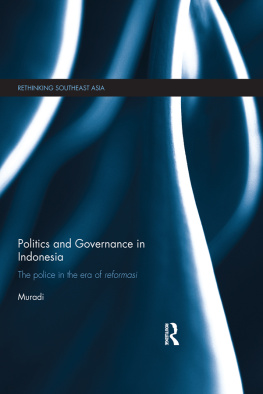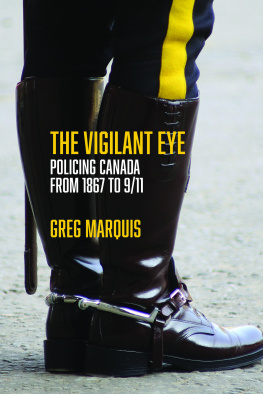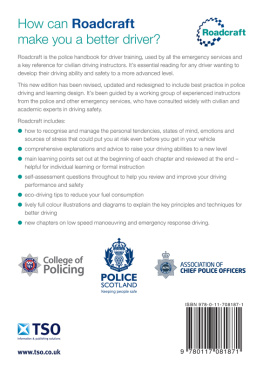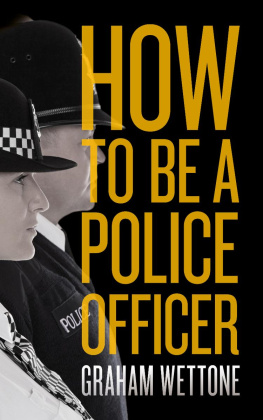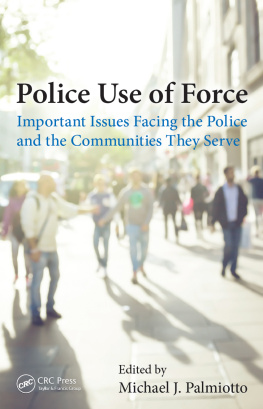CONSTABULARY
The Rise of Police Institutions in
Britain, the Commonwealth and the
United States
Dedicated to Professor Charles Bayley,
who has been a constant inspiration
throughout my academic career.
CONSTABULARY
The Rise of Police Institutions in
Britain, the Commonwealth and the
United States
HEREWARD SENIOR
Copyright Hereward Senior 1997
All rights reserved. No part of this publication may be reproduced, stored in a retrieval system, or transmitted in any form or by any means, electronic, mechanical, photocopying, recording, or otherwise (except for brief passages for purposes of review) without the prior permission of Dundurn Press Limited. Permission to photocopy should be requested from the Canadian Reprography Collective.
Editor: Nigel Wood
Designer: Sebastian Vasile
Printer: Best Book Manufacturers
Canadian Cataloguing in Publication Data
Senior, Hereward
Constabulary: the rise of police institutions in Britain, the Commonwealth and the United States
Includes bibliographical references and index.
ISBN 1-55002-246-6
1. Police Great Britain History. 2. Police Commonwealth countries History. 3. Police United States History. I. Title.
HV7903. S46 1997 | 363.2'09 | C96-932588-6 |
1 2 3 4 5 NW 01 00 99 98 97
The publisher wishes to acknowledge the generous assistance of the Canada Council, the Book Publishing Industry Development Program of the Department of Canadian Heritage, and the Ontario Arts Council.
Care has been taken to trace the ownership of copyright material used in this book. The author and the publisher welcome any information enabling them to rectify any references or credit in subsequent editions.
Printed and bound in Canada.
Printed on recycled paper.

Dundurn Press
2181 Queen Street East
Suite 301
Toronto, Ontario, Canada
M4E 1E5
Dundurn Press
73 Lime Walk
Headington, Oxford,
England
OX3 7AD
Dundurn Press
250 Sonwil Drive
Buffalo, NY
U.S.A. 14225
CONTENTS
PREFACE
THIS BOOK IS BASED ON a series of lectures dealing with police institutions which I began twenty years ago. It then attracted 16 students: last years enrolment was ninety. As there existed no suitable text for the course, my lecture notes soon became the basis of one. Since I had other writing obligations, some years elapsed before I could turn these notes into a manuscript suitable for publication. As it stands now I hope it may prove a useful aid to those engaged in police work, including those employed by private security agencies, as well as be of interest to the general public.
In my lectures I attempted to explain the origins of common law and the problem it presented to law enforcement. There existed for centuries well-founded doubts about the compatibility of professional police with common law. In the course of these lectures I also endeavoured to explain how, by degrees, these doubts were overcome, with the resulting emergence of imperfect but reasonably efficient professional forces operating in different areas of the world with common law jurisdictions. No effort was or is made to provide a comprehensive treatment of all such forces, but in tracing the history of several of the largest, representative of others, the intention remains to sketch how they came into being and developed.
In preparing this study my principal coadjutor has been Bruce Dolphin, of the McGill University Archives, who struggled with my handwriting and put the text into word-processor form. Nigel Wood, of Dundurn Press, was also of great assistance, as was and the two colour photographs used on the cover, and to Claudia Willetts for making the index. I also wish to thank Prof. David Mulhall, of Montreals Dawson College, a former Bermuda policeman, and Fred Gaffen, of the Canadian War Museum, who have enlivened my course with fascinating guest lectures. Finally, I owe a debt to my graduate student, and for the last two years my teaching assistant in the police course, Marc Drolet.
CHAPTER I
ORIGIN OF COMMON LAW POLICE:
ANGLO-SAXONS TO 18TH CENTURY
THIS VOLUME IS AN EFFORT to trace the origins and major developments of police institutions under the common law jurisdiction broadly shared by Great Britain and those parts of the globe significantly influenced by the British Empire and its constitutional-legal heritage. Therefore, while England is the point of departure, Ireland, Canada, the United States, Australia, India and South Africa are also featured. Common laws perhaps most readily recognized feature is the presumption of innocence: the burden of proof rests on the accuser. Other long established key components are habeas corpus and further protections against arbitrary search and seizure; freedom of speech, association and assembly; and trial by jury. Such principles superintend and inform the common law system, but it is rather with its human agents or rather one particular set of them, the police, not judges nor lawyers nor other officers of the court that this study is mainly concerned.
Common law places restraints on the exercise of police power not found in most societies, though some element of the police function is present in any community. Primitive societies, having little division of labour, are as a rule self-policing, with the enforcement of standards of approved behaviour vested virtually in the whole community. As the division of labour develops, the police function is increasingly provided by amateur, unpaid individuals in rudimentary organizations. But it is only with the coming of civilization and its highly sophisticated divisions of labour that professional police forces can make their appearance.
In Anglo-American society the latest stage of law enforcement came late, indeed when it was long over due. For this a price was paid in crime waves, civil disorder and human suffering, but the end achievement was the creation of police forces in the common law tradition dedicated to the idea of public service rather than public domination, the first professionals on the scene in this connection being the London Metropolitan Police in 1829. This force provided a model, never perfectly reproduced, not only for urban police in most parts of the world where English common law prevailed, but for the more peaceful of their rural areas as well. The unsuitability of this example for frontier societies or for otherwise chronically disturbed rural areas, however, led to the adoption in such cases of a different approach. There, the model turned out to be the Royal Irish Constabulary which (at first known simply as the Irish Constabulary) emerged in Ireland in 1836, seven years after the advent of the London Metropolitan Police.
Professional police appear in ancient times, reaching a kind of peak in the early centuries of the Roman Empire. Yet they and their predecessors, as far as can be determined, thought of themselves as agents of state power and control rather than servants of their fellow citizens or society in the wider sense. The English experience was unique, made possible by the insular character of Britain which enabled its inhabitants to accept handicaps which would have ruined any of the contemporary Continental states. England in due course shared this privilege with the American Colonies, protected as they were by isolation and sea power. In consequence, Britain could fight a civil war without external intervention in the seventeenth century, just as the Americans did in the nineteenth century. Societies less favorably endowed geographically found that their domestic quarrels often brought opportunistic foreign intervention.


